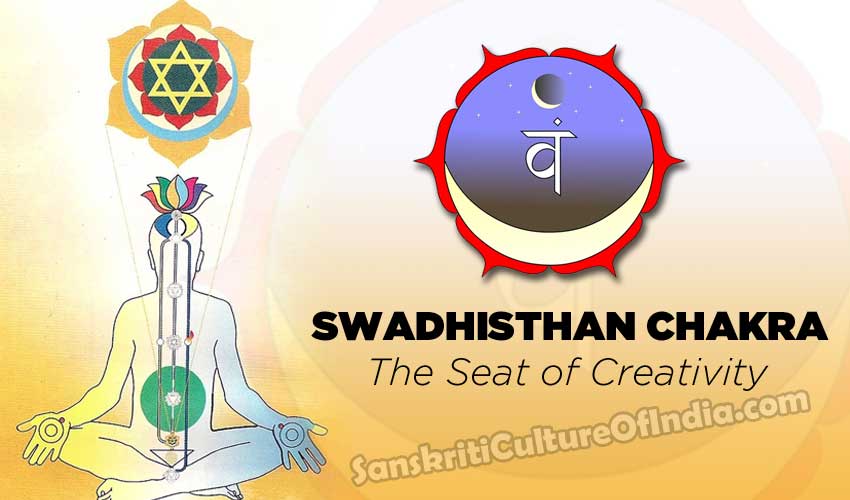Swadhisthan Chakra is the second chakra related to creativity, pure attention and pure knowledge. It is the one which connects us to the inner source of inspiration, and enables us to experience the beauty around us. The pure knowledge given by this chakra is not mental, but it is direct perception of the Reality, that can be felt in our palms and indicates our subtle blockages. Also this is the center of pure, steady attention and power of concentration.
It has six petals and caters on the physical level to functions of the aortic plexus, and is the one which supplies us with the energy of creativity, of thinking, of being futuristic. It supplies Power to the brain cells by converting fat cells into brain cells.
In the course of evolution, humans translated his need for shelter and security into the building of homes. As his sense of aesthetics developed he continued to improve on these forms of shelter (until eventually architecture came about). This creativity evolved into abstract form, where he could imagine, project and create an image which had no previous counterpart. From this burgeoning aestheticism came the creative arts.
The fundamental quality of the Swadhisthan Chakra is that of creativity. It is here that the energy for our creativity is generated. After Self-Realization we discover that the true key to creativity is in achieving the state of thoughtless awareness (nirvichara samadhi) through meditation.
From this we discover that all the beauty of Creation is reflected within us like a still and silent lake. Once we locate this pool of beauty we can become the channel for it. We become the Collective Unconscious, without ego to distort the purity of art.
The process of creativity in whatever form draws on the qualities of the Swadhisthan Chakra. If this process is accomplished in a balanced state (i.e., using the energies of the central or Sushumna channel in the subtle system) then the result is spiritually enhanced. After Self-Realization this is emphasized, and the resulting creation can become an inspired work. We can see this by looking at the classic works from artists of the past such as Mozart and Michaelangelo who were born as evolved realized souls. Works of this quality are immortal, and provide joy and beauty which define a whole epoch.
However in the modern process, we can see that even where the artistic endeavor starts out ‘with heart,’ there is a tendency for the artist to produce later works which are flat, lifeless or even exploitative. The primary cause of this tendency is the ego of the artist. As the artist becomes more successful, he or she works harder to maintain or grow this success. This requires more exhaustive use of the right channel (the Pingala Nadi or Channel of Action). A by-product of this channel becoming exhausted is that the ego of the artist becomes inflated. Note that in subtle terms the ego is actually situated at the end of the action channel (in the balloon-like shape on the left-hand side of the head). If one is confused by an inflated ego, the excessiveness drains the central channel of energy and exhausts the right side. In addition, the connection with the ego can take the attention away from the Spirit. As the artist starts to believe that he is the creator of all his works (thus eliminating divine inspiration) the process is accelerated and the ego expands to such an extent that the spiritual content of the work is removed completely.
The Spirit, which resides in our heart, is the real reservoir of creativity, and artists and people who think excessively or are obsessed with fame or success will usually suffer a weak Swadhisthan Chakra and tend to be off-balance personalities. Their ambition is to be superior to others or to be acclaimed by them for their talents comes from their ego, which is connected to the right-side of the Swadhisthan Chakra through the right channel. Their spontaneity is lost in this ambitious and competitive effort to create, and this explains why most modern creation in any aspect lacks Spirit.
One of the most important functions of this center is to generate the energy that fuels our thinking by breaking down fat particles in the abdomen to replace the brain cells. Excessive thinking and planning overworks this process and exhausts the centre. The Swadhisthan also looks after the liver (along with the Nabhi Centre). If the Chakra is having to cope with excessive thinking, then the other organs it is supposed to look after are neglected. The liver is particularly susceptible to this neglect.
The liver has a particular importance in that it is the seat of our Attention (chitta). Attention should not be confused with thought, which comes from ego (our I-ness) and superego (our past conditioning and upbringing). Attention is pure concentration minus thought/mental activity. For example when we look at a flower we put our pure attention on it (i.e., we observe it). However we will also think about it (“that’s pretty,””I wonder what’s it called,”etc.). Attention has no such associated thoughts — it is pure concentration/observation/witnessing. A balanced liver sustains and nourishes our Attention and filters it by scanning out any impurities and external clutter. From this purified attention comes the peace and stillness that we obtain in our meditation. The liver is susceptible to overheating (through alcohol or other stimulants), effecting our Attention, which ultimately weakens our meditation and so on.
The presiding deity for the Swadhisthan Chakra is Shri Brahmadeva. He represents the Creator, and has as His power Shri Saraswati, who is the Goddess of music and arts. He bestows purity, creativity, Pure Knowledge, and cuts the Knot of Maya (material attachment) and frees the seeker from earthly desires.








